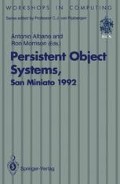Abstract
One objective of persistent languages is to permit the structure and semantics of data to be expressed precisely and simply. As a result programs are easier to write and the integrity of the data is less likely to be compromised. This paper presents a persistent programming language which includes a constraint definition and checking system. The language uses a semantic data model to define the structure and operations on data. The paper begins with a description of the features of semantic data models and constraint enforcement systems. The constraint definition aspects of the language Perci are then explained, along with an outline of the implementation of the constraint handling system. Perci is compared with existing persistent languages and the advantages of the new language are indicated.
Access this chapter
Tax calculation will be finalised at checkout
Purchases are for personal use only
Preview
Unable to display preview. Download preview PDF.
References
Antonio Albano, Luca Cardelli, and Renzo Orsini. Galileo: A Strongly-Typed, Interactive Conceptual Language. ACM Transactions on Database Systems, 10 (2): 230–260, June 1985.
Malcolm Atkinson and O. Peter Buneman. Types and Persistence in Database Programming Languages. ACM Computing Surveys, 19(2):105–190, June 1987.
Francois Bancilhon and Peter Buneman. Advances in Database Programming Languages, chapter 12, pages 187–217. Addison-Wesley, 1990.
C. J. Date. An Introduction to Database Systems, volume 2 of The Systems Programming Series, chapter 2, pages 35–81. Addison-Wesley, 1984.
Alan Dearle. On the Construction of Persistent Programming Environments. Technical Report 65, University of St. Andrews, March 1988.
Michael Hammer and Dennis McLeod. Database Description with SDM: A Semantic Database Model. ACM Transactions on Database Systems, 6 (3): 351–386, September 1981.
R. Morrison, F. Brown, R. Connor, and A. Dearle. The Napier88 Reference Manual. Persistent Programming Research Report 77, Universities of Glasgow and St Andrews, July 1989. PPRR-77–89.
John Mylopoulos, Philip A. Bernstein, and Harry K. T. Wong. A Language Facility for Designing Database-Intensive Applications. ACM Transactions on Database Systems, 5 (2): 185–207, June 1980.
Shan-Hwei Nienhuys-Cheng. Classification and Syntax of Constraints in Binary Semantical Networks. Information Systems, 15 (5): 497–513, 1990.
Gabriel Olusegun Owoso. Data Descripton and Manipulation in Persistent Programming Languages. PhD thesis, University of Edinburgh, Department of Computer Science, December 1984. CST-32–84.
Joan Peckham and Fred Maryanski. Semantic Data Models. ACM Computing Surveys, 20 (3): 153–189, September 1988.
Persistent Programming Research Group. PS-algol Reference Manual, 2nd edition, 1985. PPRR-12–85.
J. W. Schmidt, H. Eckhardt, and F. Matthes. DBPL Report. Fachbereigh Informatik, Johann Wolfgang Goethe-Universitat, draft edition, November 1988.
John Miles Smith and Diane C. P. Smith. Database abstractions: Aggregation and generalization. ACM Transactions on Database Systems, 2 (2): 105–133, June 1977.
Shane B Sparg. Syntax of the language Perci. Technical Report, March 1992.
Author information
Authors and Affiliations
Editor information
Editors and Affiliations
Rights and permissions
Copyright information
© 1993 British Computer Society
About this paper
Cite this paper
Sparg, S.B., Berman, S. (1993). Semantic Constructs for a Persistent Programming Language. In: Albano, A., Morrison, R. (eds) Persistent Object Systems. Workshops in Computing. Springer, London. https://doi.org/10.1007/978-1-4471-3209-7_18
Download citation
DOI: https://doi.org/10.1007/978-1-4471-3209-7_18
Publisher Name: Springer, London
Print ISBN: 978-3-540-19800-0
Online ISBN: 978-1-4471-3209-7
eBook Packages: Springer Book Archive

